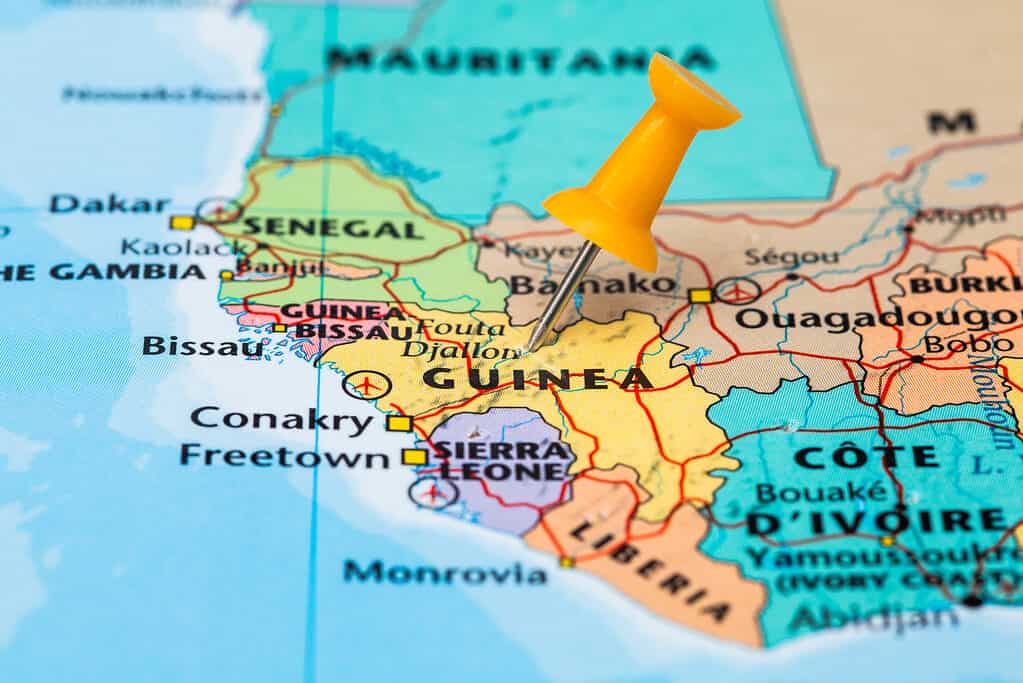Guinea is a country located in West Africa, bordered by Guinea-Bissau, Senegal, Mali, Côte d’Ivoire, Liberia, and Sierra Leone. Guinea achieved independence from France on October 2, 1958. It was the first French colony in Africa to become independent. Independence brought a lot of changes, including a change of the flag from the French tricolor to the new flag of Guinea. Discover with us what the flag looks like and what it means.

Guinea is a country located in West
Africa
, bordered by Guinea-Bissau, Senegal, Mali, Côte d’Ivoire, Liberia, and Sierra Leone.
©Wead/Shutterstock.com
What Does the Name Guinea Mean?
“Guinea” is a name that was used by European colonial powers for the West African coast starting in the 18th century. Different European countries carved out their own “Guinea” colonies: Guinea, Spanish Guinea, and Portuguese Guinea. Because the area was rich in gold, “guinea” also became a term used for a British gold coin. Guinea’s neighbor to the north, Portuguese Guinea, became independent in 1973. To keep the names from getting confused, Portuguese Guinea added the name of its capital to its country name. So today it is called “Guinea-Bissau.”
Earlier Designs for the Flag of Guinea
Before getting its freedom, Guinea was a colony of France and flew the French tricolor, with three vertical bands of blue, white, and red. As different groups and political parties advocated for self-government, independent movements in Guinea started developing their own flags.
The Democratic Party of Guinea (PDG) which was led by Ahmed Sékou Touré, used a red-black-green flag with a yellow star in the center. The red color represented the blood of the people who died fighting for independence. The black was for the African continent. Green represented hope and the yellow star was a symbol of the unity of the people. The African Democratic Rally (RDA), the main political party in French West Africa, used a flag with pan-African colors. The flag was similar to the current national flag of Guinea, with the same colors but arranged differently.

The flag of Guinea features three equal vertical bands of red, yellow, and green.
©Design_Bank/Shutterstock.com
Symbolism of the Flag of Guinea
The flag of Guinea consists of three equal vertical bands of red, yellow, and green – a similar design as the French flag, but with different colors. The red band represents the people’s blood sacrificed for the country’s independence. The yellow band represents the sun, as well as Guinea’s minerals and other natural resources. The green band represents the country’s green vegetation and agriculture.
The colors of the flag also reflect the Pan-African colors, shared by the flags of many nations on the continent to symbolize their unity. The colors of the flag were also chosen to reflect the colors of the two main political parties in the independence struggle: the Democratic Party of Guinea (PDG) and the African Democratic Rally (RDA).
The photo featured at the top of this post is © Design_Bank/Shutterstock.com
FAQs (Frequently Asked Questions)
What do the colors of the flag represent?
The red band represents the people’s sacrifice for the country’s freedom and the shedding of blood for the country’s independence. The yellow band represents the sun, as well as the mineral wealth of the country. The green band represents the country’s lush vegetation and natural resources, as well as its agricultural wealth.
What does the word “guinea” mean?
The origins of the name “Guinea” are unclear but it may be a corruption of a Tuareg Berber language word “aginaw” referring to black people. The Portuguese used the term “Guine” to refer to the area around Senegal, but by the 18th century it had become a term Europeans used for a broad stretch of the West African coast.
Thank you for reading! Have some feedback for us? Contact the AZ Animals editorial team.






